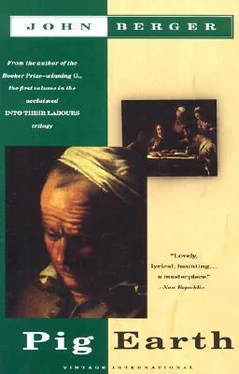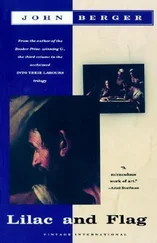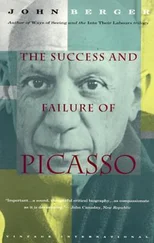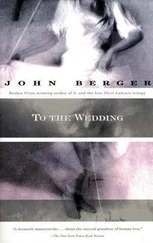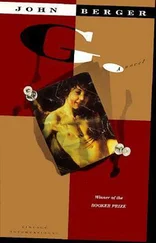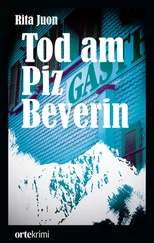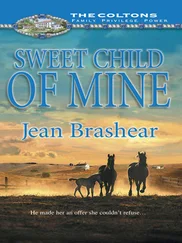The pig’s hind legs were ten centimetres off the ground.
“Head from body in ONE!” Pépé shouted and severed the head in one long cut with his small knife.
The body fell.
“The head for you!” he nodded towards me. I knew what I had to do. I took it, and ran up the pile of snow in the courtyard so fast that my feet made footholds and I reached the top. And there on the white summit I placed the pig’s head.
The men were drinking their second glass of gnôle.
Into each hind leg, between the two bones, Pépé inserted a small hook. This time we hoisted up the carcass, neck down. The crows were too frightened by the men in the courtyard to approach the head on the pile of snow.
Delicately, from anus to neck, down the centre of the stomach, making an insertion with his knife, Pépé folded back the skin and fat. “Andre!” He said my name between his teeth because he was concentrating so hard.
He had made visible all that makes a pig a living, growing animal. All except the brain and head which were on the snow pile. The arrangement of the warm, steaming organs was the same as inside a rabbit. It was their size which was so impressive. When his belly was opened, it was like the mouth of a cave.
Pépé once admitted to me that he had dug for gold. During one summer he and a friend had got up two hours earlier every morning to go and dig there. They found nothing; but he showed me the shaft, should I ever wish to continue working it. It was hidden in a moraine on a steep wooded slope, where the boulders, the tree roots and the soil itself were all covered with a thick green moss. Whatever you touched there was like the fur of an animal.
I held one side of the zinc pan and Marius held the other, waiting for the guts and stomach to tumble out. Using only the point of his knife, as a woman does when unpicking stitches with the tip of her scissors, Pépé detached them. The grey guts overflowed the pan and we had to hold them in with our hands. They were warm and from them came the smell of killing.
The pig’s liver, the pig’s lungs, whitish-pink like two sprays of pear blossom, the pig’s heart, Pépé removed separately.
I ran to the top of the snow pile again and turned the head round so that it faced its empty carcass. Underneath the head the blood had thawed a little snow, making a red cave. Standing on top of the snow pile, my head was level with the balustrade of the wooden balcony, where I had played when I could first walk. The men down below were throwing buckets of water over the carcass and rubbing it down, inside and out, with a cloth. Then they went in to eat.
Down the centre of the table were loaves of fresh bread and large bottles of cider. There were two kinds of cider, the sweet cider which we had pressed only two months before, and last year’s, which was stronger. The older one was easy to distinguish because it was cloudier. Most of the women drank the new cider.
From a large black cast-iron pot on the stove, my mother filled the soup tureen to put on the table. To celebrate the killing of the new pig, we were going to eat what remained of the old.
In the soup, made with parts of the salted backbone, were carrots, parsnips, leeks, turnips. The loaves were passed round and held against each chest in turn, as a slice was cut off. Then, spoons in hand, we entered the meal.
Some of the men started to talk about the war. The body of another German soldier had been discovered a few weeks before in a crevice high up in the forest. This was the winter of 1950.
“If he’d stayed at home, he’d be sleeping today with his wife in his bed.”
I was drinking the strong cider and listening to each conversation.
Every year, when the pig was killed, all the neighbours and Monsieur le Curé and the schoolmaster were invited to eat. The schoolmaster was sitting near Pépé at the head of the table. I was anxious in case he told Pépé about the hedgehog. The hedgehog was discovered in the schoolroom cupboard where the schoolmaster kept his coat. We called him The Hedgehog because his hair stood up at the back. He had very small hands too. And he wore glasses. Standing before the class, he invited whoever had put the hedgehog in the cupboard to remove it. Nobody got up. Nobody dared look at me. Then he asked: “Who knows why hedgehogs smell?” Like a fool, I put up my hand and said they made a smell when they were frightened.
“Then since you know more about him than any of the others, please remove him.” The others began to laugh and some shouted Bravo! in such a way that he realised he had picked the culprit. As a punishment, he made me learn and recite out loud a page about hedgehogs. He brought the book himself next day, and I had to sit in the schoolroom until I had learnt it. I still remember how it began: “The fox knows many little things and the hedgehog knows one big thing.” I wondered whether he had read the text himself, because a few lines further down it explained that, because of their spines, hedgehogs could not mate like other animals, but had to do so standing up, and face to face like men and women.
I was reassured, for the schoolmaster was making Pépé laugh. Opposite me La Fine, who lived below our fields and could take away the pain of burns, was telling a story about Joseph, her brother-in-law. He went to C … on a day when there was a fête and a band. He came back late at night convinced that in one of the cafés he had pissed into a golden lavatory! It turned out he had pissed into a bandsman’s bassoon!
My mother never sat down. She went round the table serving. When she brought the stuffed cabbages on, we all cheered. “Wait till you taste them!” she cried, full of confidence. They had been cooking since early morning in a net in a deep pot. First she put a plate into the bottom of the net, then on the plate a layer of cabbage leaves, then a layer of stuffing of minced pork and eggs and shallots and marjoram, then a layer of leaves, then a layer of stuffing, until the net was as full and heavy as a goose. When I was younger I had watched her do it. Now I was drinking last year’s cider like a man.
“I would like to know what life was like ten thousand years ago,” Pépé was saying. “I think of it often. Nature would have been the same. The same trees, the same earth, the same clouds, the same snow falling in the same way on the grass and thawing in the spring. People exaggerate the changes in nature so as to make nature seem lighter.” He was talking to a neighbour’s son who was on leave from the army. “Nature resists change. If something changes, nature waits to see whether the change can continue, and, if it can’t, it crushes it with all its weight! Ten thousand years ago the trout in the stream would have been exactly the same as today.”
“The pigs wouldn’t have been!”
“That’s why I would like to go back! To see how the things we know today were first learnt. Take a chevreton. It’s simple. Milk the goat, heat the milk, separate it and press the curds. Well, we saw it all being done before we could walk. But how did they once discover that the best way of separating the milk was to take a kid’s stomach, blow it up like a balloon, dry it, soak it in acid, powder it and drop a few grains of this powder into the heated milk? I would like to know how the women discovered that!”
At the other end of the table the guests were listening to Mémé who was telling a story. There were two cousins in a nearby village who lived side by side because they inherited the same property …
“That is what I would like to know if I was a crow on a tree watching!” Pépé was saying. “All the mistakes which had to be made! And step by step, slowly, the progress!”
The two cousins fall out and start a fight. One of them bites a piece out of the other’s nose. Both are too frightened to continue fighting. A few days later the bitten one is digging in his garden, with a cloth over his nose. He sees his cousin coming out of the house on the other side of the fence. “Well, well!” he shouts. “Are you feeling hungry today? Why not come over and finish off the rest of the nose?”
Читать дальше
